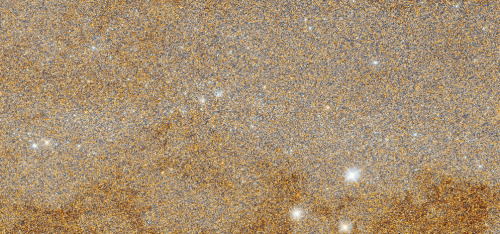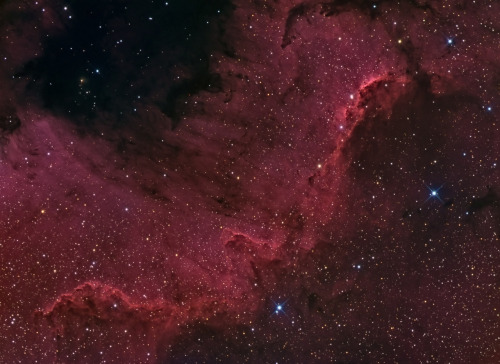A Shot Of Just A Tiny Bit Of The Andromeda Galaxy, From The Sharpest Ever View Taken By The Hubble Space

A shot of just a tiny bit of the Andromeda Galaxy, from the sharpest ever view taken by the Hubble Space Telescope
Full size image
More Posts from Littlecadet-biguniverse and Others

M63, Sunflower Galaxy

New view of the Pillars of Creation - infrared
js

A cosmic concoction in NGC 2467
js

Location: Hawaiian Island of Maui Photo: Jeff Berkes

Crescent Nebula

What forms lurk in the mists of the Carina Nebula? The dark ominous figures are actually molecular clouds, knots of molecular gas and dust so thick they have become opaque. In comparison, however, these clouds are typically much less dense than Earth’s atmosphere. Featured here is a detailed image of the core of the Carina Nebula, a part where both dark and colorful clouds of gas and dust are particularly prominent. The image was captured last month from Siding Spring Observatory in Australia. Although the nebula is predominantly composed of hydrogen gas – here colored green, the image was assigned colors so that light emitted by trace amounts of sulfur and oxygen appear red and blue, respectively. The entire Carina Nebula, cataloged as NGC 3372, spans over 300 light years and lies about 7,500 light-years away in the constellation of Carina. Eta Carinae, the most energetic star in the nebula, was one of the brightest stars in the sky in the 1830s, but then faded dramatically.
Object Names: Carina Nebula
Image Type: Astronomical
Credit: John Ebersole
Time And Space

NGC 2736: The Pencil Nebula
js

Hubble views a spectacular supernova with interstellar material over 160,000 light-years away by NASA Goddard Photo and Video on Flickr.
This NASA/ESA Hubble Space Telescope image captures the remnants of a long-dead star. These rippling wisps of ionized gas, named DEM L316A, are located some 160,000 light-years away within one of the Milky Way’s closest galactic neighbors — the Large Magellanic Cloud (LMC). The explosion that formed DEM L316A was an example of an especially energetic and bright variety of supernova, known as a Type Ia. Such supernova events are thought to occur when a white dwarf star steals more material than it can handle from a nearby companion, and becomes unbalanced. The result is a spectacular release of energy in the form of a bright, violent explosion, which ejects the star’s outer layers into the surrounding space at immense speeds. As this expelled gas travels through the interstellar material, it heats up and ionizes it, producing the faint glow that Hubble’s Wide Field Camera 3 has captured here. The LMC orbits the Milky Way as a satellite galaxy and is the fourth largest in our group of galaxies, the Local Group. DEM L316A is not the only supernova remnant in the LMC; Hubble came across another one in 2010 with SNR 0509, and in 2013 it snapped SNR 0519. Image credit: ESA (European Space Agency)/Hubble & NASA, Y. Chu

Southern NGC7000
js
-
 knight-of-obliveon reblogged this · 3 weeks ago
knight-of-obliveon reblogged this · 3 weeks ago -
 bewtifulfreak liked this · 1 month ago
bewtifulfreak liked this · 1 month ago -
 takemetoyourspeakers reblogged this · 1 month ago
takemetoyourspeakers reblogged this · 1 month ago -
 atwater liked this · 1 month ago
atwater liked this · 1 month ago -
 brittneygruber reblogged this · 1 month ago
brittneygruber reblogged this · 1 month ago -
 kisssykissy reblogged this · 2 months ago
kisssykissy reblogged this · 2 months ago -
 itsspookymulder reblogged this · 2 months ago
itsspookymulder reblogged this · 2 months ago -
 darkempressrising reblogged this · 2 months ago
darkempressrising reblogged this · 2 months ago -
 dowsabel reblogged this · 2 months ago
dowsabel reblogged this · 2 months ago -
 ta6ia liked this · 2 months ago
ta6ia liked this · 2 months ago -
 darknstormyseas liked this · 2 months ago
darknstormyseas liked this · 2 months ago -
 starkystarkyboomboom reblogged this · 2 months ago
starkystarkyboomboom reblogged this · 2 months ago -
 dindjarinsgf liked this · 2 months ago
dindjarinsgf liked this · 2 months ago -
 involuntarias reblogged this · 3 months ago
involuntarias reblogged this · 3 months ago -
 onlyasucker reblogged this · 3 months ago
onlyasucker reblogged this · 3 months ago -
 onlyasucker liked this · 3 months ago
onlyasucker liked this · 3 months ago -
 cenciarelliss liked this · 3 months ago
cenciarelliss liked this · 3 months ago -
 ketamina reblogged this · 3 months ago
ketamina reblogged this · 3 months ago -
 hemoglobin reblogged this · 3 months ago
hemoglobin reblogged this · 3 months ago -
 beeyzaaa liked this · 3 months ago
beeyzaaa liked this · 3 months ago -
 umcaralh liked this · 3 months ago
umcaralh liked this · 3 months ago -
 parimastparim reblogged this · 3 months ago
parimastparim reblogged this · 3 months ago -
 hemoglobin reblogged this · 3 months ago
hemoglobin reblogged this · 3 months ago -
 bunnitjump liked this · 4 months ago
bunnitjump liked this · 4 months ago -
 angelbunies reblogged this · 4 months ago
angelbunies reblogged this · 4 months ago -
 imeverysparklywoman reblogged this · 5 months ago
imeverysparklywoman reblogged this · 5 months ago -
 pancake-aura reblogged this · 5 months ago
pancake-aura reblogged this · 5 months ago -
 starduhst reblogged this · 5 months ago
starduhst reblogged this · 5 months ago -
 ufoenthusiast reblogged this · 5 months ago
ufoenthusiast reblogged this · 5 months ago -
 starduhst liked this · 5 months ago
starduhst liked this · 5 months ago -
 no32557038 liked this · 5 months ago
no32557038 liked this · 5 months ago -
 lightofearendil liked this · 5 months ago
lightofearendil liked this · 5 months ago -
 holyborn reblogged this · 6 months ago
holyborn reblogged this · 6 months ago -
 jordkeely reblogged this · 6 months ago
jordkeely reblogged this · 6 months ago -
 halloweenhooves liked this · 6 months ago
halloweenhooves liked this · 6 months ago -
 f0und-the-devil-in-me liked this · 6 months ago
f0und-the-devil-in-me liked this · 6 months ago -
 jnv6 reblogged this · 6 months ago
jnv6 reblogged this · 6 months ago -
 urlurlurlksb liked this · 7 months ago
urlurlurlksb liked this · 7 months ago -
 floorpills reblogged this · 7 months ago
floorpills reblogged this · 7 months ago -
 stratabilly liked this · 8 months ago
stratabilly liked this · 8 months ago -
 angel-of-fallen-dreams liked this · 8 months ago
angel-of-fallen-dreams liked this · 8 months ago -
 countessvant reblogged this · 8 months ago
countessvant reblogged this · 8 months ago -
 celineuxa reblogged this · 8 months ago
celineuxa reblogged this · 8 months ago -
 islandinyourself liked this · 9 months ago
islandinyourself liked this · 9 months ago -
 welcometotheblueside reblogged this · 9 months ago
welcometotheblueside reblogged this · 9 months ago -
 mintymoonmama reblogged this · 9 months ago
mintymoonmama reblogged this · 9 months ago -
 7evnty liked this · 9 months ago
7evnty liked this · 9 months ago -
 robinniko reblogged this · 9 months ago
robinniko reblogged this · 9 months ago
GREETINGS FROM EARTH! Welcome to my space blog! Let's explore the stars together!!!
144 posts
